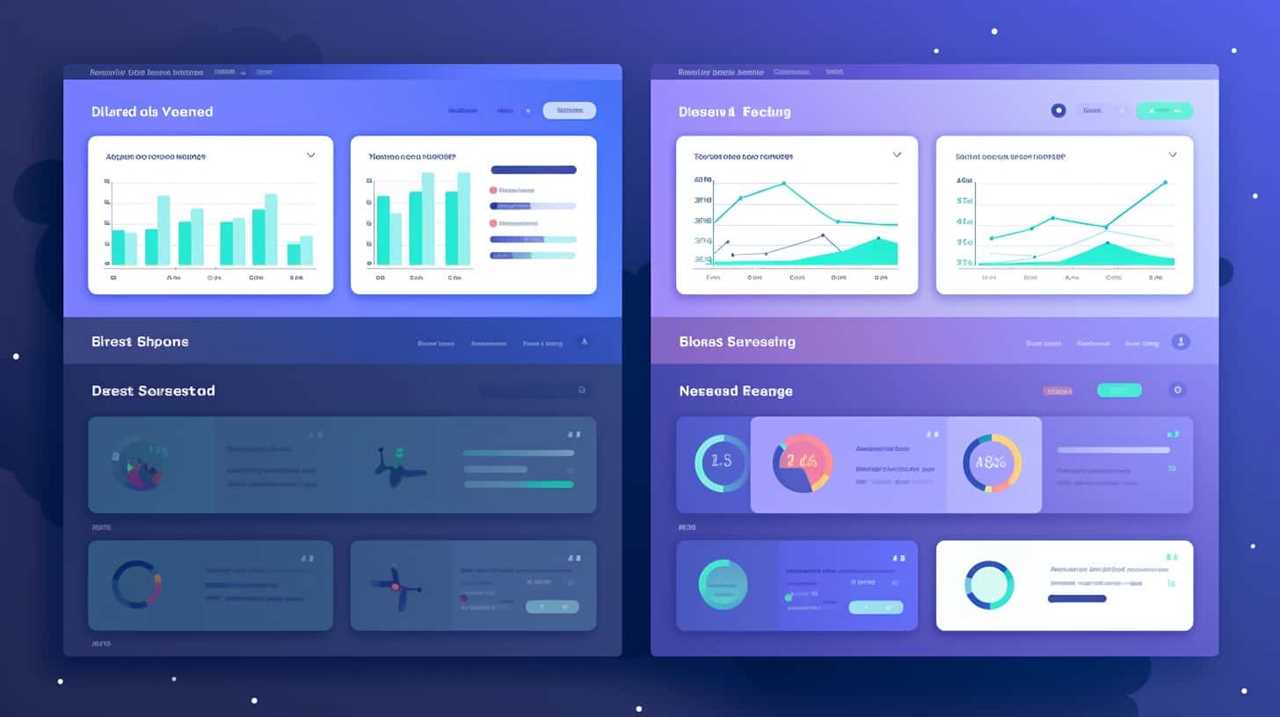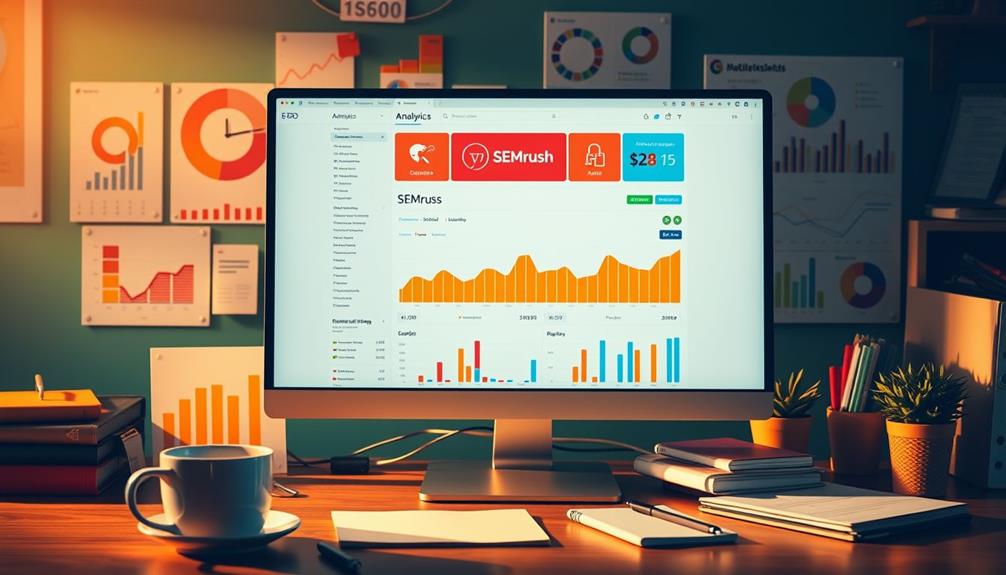Ready to elevate your SEO game? We’ve got the crucial advice you need for pinpoint accuracy in selecting your keywords.
In this article, we’ll share 15 actionable tips for optimizing your website’s SEO. From conducting thorough keyword research to monitoring performance regularly, we’ll guide you through the process of refining your strategy.
Stay ahead of the competition and achieve mastery in the world of SEO with our expert advice.
Key Takeaways
- Use tools and techniques to identify relevant and high-performing keywords
- Analyze keyword trends and search volume to understand user search intent
- Prioritize and select impactful keywords
- Utilize long-tail keywords to target niche audiences and increase conversion rates
Conduct Thorough Keyword Research
We begin by conducting thorough keyword research using tools and techniques to identify the most relevant and high-performing keywords for our targeted SEO strategy. This step is crucial in understanding user search intent and optimizing our website accordingly.

By analyzing keyword trends and search volume, we gain insight into the topics and phrases users are searching for. This data allows us to tailor our content to match their needs and preferences, ultimately improving our website’s visibility and driving organic traffic.
Additionally, we utilize various keyword analysis techniques to evaluate the competitiveness and potential of each keyword. This helps us prioritize and select the keywords that will have the greatest impact on our SEO efforts.
With a comprehensive keyword research process, we can ensure that our targeted SEO strategy aligns with user search intent and maximizes our online presence.
Understand Your Target Audience’s Search Intent
Understanding your target audience’s search intent is crucial for successful SEO.

By analyzing users’ search behavior, we can gain insights into what they’re looking for and optimize our content relevance accordingly.
This involves employing effective keyword research techniques to uncover the specific terms and phrases that align with our audience’s search intent.
User’s Search Behavior
To effectively optimize your website for targeted SEO, it is essential to comprehend the search behavior of your target audience and accurately determine their search intent. Understanding how users search for information online can help you tailor your content and keywords to meet their needs. By analyzing user engagement and studying search engine algorithms, you can gain valuable insights into the preferences and behaviors of your target audience.
| Search Behavior | Search Intent |
|---|---|
| Long-tail keywords | Detailed information |
| Question queries | Seeking answers or solutions |
| Location-based | Local businesses |
| Comparison searches | Evaluating options |
| Brand-specific | Specific product or service |
Optimize Content Relevance
By analyzing user engagement and studying search engine algorithms, we can gain valuable insights into the preferences and behaviors of our target audience, allowing us to optimize our content for maximum relevance to their search intent.

To optimize content relevance, it’s essential to focus on two key factors: content structure and keyword density.
First, optimizing content structure involves organizing information in a logical and intuitive manner, making it easy for users to navigate and find what they’re looking for. This includes using headings, subheadings, bullet points, and clear formatting.
Second, improving keyword density entails strategically incorporating relevant keywords throughout the content to signal its relevance to search engines. By aligning our content with the search intent of our target audience, we can increase the chances of our website appearing in the top search results.
Transitioning into the next section on ‘keyword research techniques,’ let’s explore how we can identify the most effective keywords for our content.

Keyword Research Techniques
To understand our target audience’s search intent and effectively conduct keyword research, we can employ various techniques that provide valuable insights into the keywords with topical precision.
The first step is to utilize keyword research tools such as Google Keyword Planner, SEMrush, or Ahrefs. These tools allow us to explore relevant keywords, analyze search volume, and identify competition levels.
Additionally, we can employ keyword analysis techniques like competitor analysis, content gap analysis, and semantic keyword research. By analyzing our competitors’ keywords and identifying gaps in their content, we can discover valuable keyword opportunities.
Furthermore, understanding semantic keywords helps us uncover related terms and phrases that our target audience may be searching for.

By employing these keyword research techniques, we can gain a deeper understanding of our target audience’s search intent and optimize our content accordingly.
In the next section, we’ll explore the use of long-tail keywords for better specificity.
Use Long-Tail Keywords for Better Specificity
For better specificity in targeting keywords, we can achieve this by using long-tail keywords. When comparing long tail keywords vs. short tail keywords, the impact of using specific keywords becomes evident.
Long tail keywords are longer, more specific phrases that target a niche audience, while short tail keywords are broader and more general. By incorporating long-tail keywords into our SEO strategy, we can increase the specificity of our content, attracting highly relevant and qualified traffic.

These specific keywords help us to better understand the user intent and cater to their needs, resulting in higher conversion rates and improved search engine rankings.
To further enhance our keyword research, we can analyze competitor keywords for inspiration, uncovering new opportunities and gaining insights into what works in our industry.
Analyze Competitor Keywords for Inspiration
We can gain inspiration for our keyword research by analyzing competitor keywords. By studying what keywords our competitors are targeting, we can identify keyword trends and refine our own SEO strategy. Here are five reasons why analyzing competitor keywords is crucial for our success:
- Keep up with the competition: Analyzing competitor strategies helps us stay ahead of the game and ensure we don’t fall behind.
- Discover new opportunities: By identifying keyword trends, we can uncover untapped areas where our competitors might be missing out.
- Improve our targeting: Understanding which keywords our competitors are ranking for allows us to optimize our content and target the same audience effectively.
- Refine our content strategy: Analyzing competitor keywords helps us align our content strategy with what’s working well in our industry.
- Boost our SEO performance: By leveraging competitor keyword insights, we can improve our search engine rankings and drive more organic traffic to our website.
Analyzing competitor keywords is an essential part of our SEO strategy, providing us with valuable insights to optimize our keyword research and stay ahead of the competition.

Optimize Your Website’s Meta Tags and Descriptions
Optimizing your website’s meta tags and descriptions is crucial for achieving a higher ranking in search engine results.
Meta tags provide information to search engines about the content of your web pages, helping them understand what your website is all about.
By crafting relevant and compelling meta descriptions, you can entice users to click on your website when it appears in search results.
This strategic approach to meta tags and descriptions can significantly improve your website’s visibility and attract more organic traffic.

Meta Tag Importance
In optimizing our website’s meta tags and descriptions, we must focus on the importance of incorporating targeted keywords with topical precision. Meta tags play a crucial role in improving our website’s visibility and search engine rankings.
Here are the key reasons why meta tag optimization is essential:
- Enhanced Visibility: Well-optimized meta tags can attract more relevant traffic to our website.
- Higher Click-through Rates: Engaging meta descriptions increase the likelihood of users clicking on our website in search results.
- Clear Communication: Meta tags provide concise information about our webpages, helping users understand what our content offers.
- Improved User Experience: Relevant meta tags ensure that users find the information they’re looking for quickly and easily.
- Competitive Advantage: Following meta tag best practices gives us an edge over competitors in search engine rankings.
Descriptions for Ranking
To maximize our website’s ranking potential, we need to optimize our meta tags and descriptions by incorporating targeted keywords with topical precision.
Meta descriptions play a crucial role in SEO rankings. They provide a concise summary of the webpage’s content and act as a preview for users on search engine result pages. By crafting compelling and informative meta descriptions, we can entice users to click on our website and improve our click-through rates.

To optimize meta tags for better search engine rankings, we can start by using relevant keywords that accurately represent the content on our webpage. Additionally, we should keep the meta tags concise and focused, avoiding excessive keyword stuffing.
By following these strategies, we can enhance our website’s visibility and attract more organic traffic.
Now, let’s move on to the next section and explore how to incorporate keywords naturally in our website’s content.
Incorporate Keywords Naturally in Your Website’s Content
Our article offers 15 tips for incorporating keywords naturally in your website’s content to enhance targeted SEO. Achieving the right keyword density and on-page optimization is crucial for effective SEO strategies.

Here are five strategies to help you incorporate keywords seamlessly into your website’s content:
- Use long-tail keywords: Focus on specific phrases that are relevant to your target audience.
- Create informative content: Provide valuable information to your readers while naturally incorporating keywords.
- Optimize meta tags: Craft compelling meta titles and descriptions that include relevant keywords.
- Use keyword variations: Incorporate different variations of your target keywords to expand your reach.
- Prioritize user experience: Ensure that your content flows naturally and provides a seamless browsing experience.
By incorporating these strategies, you can enhance your website’s SEO while maintaining a natural and engaging user experience.
Now, let’s explore how utilizing heading tags can further highlight keyword relevance.
Utilize Heading Tags to Highlight Keyword Relevance
Heading tags serve as a powerful tool to emphasize the relevance of keywords within your website’s content. When it comes to on page SEO techniques, heading tag optimization plays a crucial role in signaling the importance of specific keywords to search engines.

By using heading tags, such as H1, H2, and H3, strategically throughout your content, you can guide search engine crawlers in understanding the structure and hierarchy of your webpage. This not only helps search engines better index your content but also allows them to recognize the main topics and subtopics within your page.
Optimize Your Website’s URL Structure
We can further improve our on-page SEO by optimizing our website’s URL structure. A well-optimized URL structure not only helps search engines understand the content of our website, but also enhances the user experience.
Here are five key reasons why optimizing our website’s URL structure is crucial for website design and optimization:
- Improved Crawlability: A clean and organized URL structure makes it easier for search engine bots to crawl and index our website.
- Keyword Relevance: Including relevant keywords in our URL can help signal to search engines the topic of our page.
- User-Friendly Navigation: A well-structured URL makes it easier for users to navigate and understand the hierarchy of our website.
- Link Building: Clear and concise URLs are more likely to be shared and linked to by other websites.
- Mobile Optimization: Optimized URLs contribute to a seamless mobile browsing experience, which is essential for website success.
Implement Internal Linking Strategies With Targeted Anchor Text
When it comes to implementing internal linking strategies with targeted anchor text, there are a few best practices to keep in mind.

First, select your anchor text carefully, ensuring that it includes your targeted keywords. This helps search engines understand the relevance of your content and improves the overall SEO of your website.
Additionally, internal linking has numerous benefits. It improves user experience by providing easy navigation and guiding visitors to related content. It also increases page authority by spreading link equity throughout your site. By linking to relevant pages, you can help search engines understand the structure and hierarchy of your website.
Anchor Text Best Practices
For implementing internal linking strategies with targeted anchor text, it’s important to utilize article determiners in order to achieve optimal results. Anchor text optimization plays a critical role in driving organic traffic and improving search engine rankings. Here are some best practices to consider:
- Use descriptive and relevant anchor text that accurately reflects the content of the linked page.
- Avoid generic anchor text like ‘click here’ or ‘read more’ as they provide little context to search engines.
- Incorporate keywords naturally into the anchor text to enhance its SEO value.
- Limit the number of links per page to maintain a good user experience and prevent keyword stuffing.
- Regularly review and update your anchor text to ensure it remains effective and aligns with your current SEO strategy.
By implementing these best practices, you can maximize the impact of your internal linking strategies and improve your website’s visibility in search engine results pages.

Now let’s explore the benefits of internal linking.
Internal Linking Benefits
One benefit of implementing internal linking strategies with targeted anchor text is that it helps improve the overall SEO performance of our website. Internal linking refers to the practice of linking one page of a website to another page within the same website.
By using targeted anchor text, we can optimize the relevance and context of the link, which in turn enhances the search engine visibility and ranking of our website. When implementing internal linking strategies, it’s important to carefully choose the anchor text to accurately reflect the content of the linked page.
By doing so, we can provide both search engines and users with valuable information about the linked page, thereby increasing its visibility and authority. This, in turn, can positively impact our website’s performance in search engine rankings and drive more organic traffic to our site.

Targeted Keyword Selection
To implement internal linking strategies with targeted anchor text, we optimize the relevance and context of the links, enhancing the search engine visibility and ranking of our website.
When it comes to targeted keyword selection, we employ a strategic approach to ensure effective keyword placement throughout our content. Here are some key considerations for targeted keyword analysis:
- Conduct thorough research to identify relevant and high-performing keywords.
- Analyze the competition to understand which keywords are being targeted by other websites in our niche.
- Prioritize long-tail keywords that have lower competition but higher conversion potential.
- Incorporate keywords naturally within the anchor text of internal links to provide context and relevancy.
- Regularly monitor and analyze the performance of our targeted keywords to make necessary adjustments.
By implementing these strategies, we can optimize our website’s visibility and attract a highly targeted audience.
Now, let’s dive into the next section about optimizing images with descriptive alt tags and filenames.

Optimize Images With Descriptive Alt Tags and Filenames
We found that optimizing images with descriptive alt tags and filenames is one of the 15 key tips for achieving targeted SEO with keywords of topical precision.
Optimizing image alt tags and filenames for SEO is crucial in ensuring that search engines can understand the content of your images and rank them appropriately. When creating alt tags, it’s important to use descriptive keywords that accurately describe the image. Additionally, using relevant keywords in the filenames can further enhance the SEO value of the image.
Best practices for image optimization also include compressing images to reduce file size and using responsive images for mobile optimization. By implementing these strategies, you can improve the visibility of your images in search results and drive more organic traffic to your website.
Now, let’s explore how you can leverage the power of social media for keyword targeting.

Leverage the Power of Social Media for Keyword Targeting
Now, let’s delve into how we can harness the power of social media to target keywords with precision.
Social media engagement and influencer marketing are two powerful tools that can significantly boost your SEO efforts.
Here are five ways to leverage social media for keyword targeting:
- Utilize hashtags strategically to increase visibility and reach.
- Engage with your audience through meaningful conversations to build trust and credibility.
- Share high-quality content that’s relevant to your target keywords to attract and retain followers.
- Collaborate with influencers in your industry to amplify your message and increase brand exposure.
- Monitor social media analytics to track keyword performance and make data-driven decisions.
Monitor and Analyze Keyword Performance Regularly
As we regularly monitor and analyze keyword performance, we can gain valuable insights into the effectiveness of our SEO strategies. Tracking SEO performance is crucial for understanding which keywords are driving traffic and conversions to our website.

By closely monitoring keyword rankings, click-through rates, and conversion rates, we can identify trends and make data-driven decisions to continuously optimize our SEO strategy. Regular analysis allows us to identify underperforming keywords and take corrective actions to improve their rankings.
Additionally, it helps us identify new keyword opportunities and stay ahead of our competitors. Through monitoring and analyzing keyword performance, we can ensure that our SEO efforts are aligned with our business goals and consistently drive targeted organic traffic to our website.
Utilize Local SEO Techniques for Geographically Targeted Keywords
By utilizing local SEO techniques, we can optimize our website for geographically targeted keywords, ensuring that our content is highly relevant to users in specific locations. This is crucial for businesses that want to reach their target audience effectively.
Here are five strategies to help you make the most of local search optimization:

- Claim and optimize your Google My Business listing: This will improve your visibility in local searches and provide users with essential information about your business.
- Use location-specific keywords: Incorporate keywords that include the names of cities or neighborhoods to increase your chances of appearing in relevant searches.
- Create location-specific landing pages: Tailor your content to different locations to provide personalized information and improve user experience.
- Encourage customer reviews: Positive reviews can boost your visibility and credibility in local search results.
- Leverage geographically targeted ads: Use paid advertising platforms to specifically target users in your desired locations.
Implementing these local SEO techniques will help you attract more relevant traffic and improve your chances of converting visitors into customers in specific geographic areas.
Stay Updated With the Latest SEO Trends and Algorithm Changes
To stay current with the latest SEO trends and algorithm changes, we should regularly update our strategies and adapt to the evolving digital landscape.
It’s crucial to stay up to date with the latest Google algorithm updates as they play a significant role in determining search engine rankings.
By understanding the impact of voice search on keyword targeting, we can optimize our content to cater to the increasing number of users using voice assistants like Siri, Alexa, and Google Assistant. Voice search is a rapidly growing trend, and incorporating it into our SEO strategy can help us reach a wider audience.

Additionally, staying updated with algorithm changes allows us to identify and implement necessary adjustments to maintain or improve our search rankings.
Continuously Optimize and Refine Your SEO Strategy
To continuously optimize and refine our SEO strategy, we need to employ effective keyword research techniques and track our SEO performance.
By conducting thorough keyword research, we can identify the most relevant and high-performing keywords for our website.
Additionally, tracking our SEO performance allows us to measure the effectiveness of our strategy and make necessary adjustments to improve our rankings and visibility.

This ongoing optimization and refinement process ensures that our SEO strategy remains effective and aligned with the evolving search landscape.
Keyword Research Techniques
We continuously optimize and refine our SEO strategy through effective keyword research techniques. To achieve mastery in this field, it’s essential to employ the right methods for keyword analysis and competitor analysis.
Here are five bullet points that will evoke an emotional response in our audience:
- Uncover hidden opportunities: By conducting thorough keyword analysis, we can identify untapped keywords that have high search volumes and low competition.
- Stay ahead of the competition: Through competitor analysis, we gain insights into the keywords our competitors are targeting, allowing us to refine our strategy and outperform them.
- Enhance relevance and user experience: By understanding user intent through keyword research, we can create content that aligns with what our target audience is searching for, improving relevance and user experience.
- Drive organic traffic: By targeting the right keywords, we increase our chances of ranking higher in search engine results, attracting more organic traffic to our website.
- Adapt to changing trends: Regular keyword research helps us stay updated on evolving search trends, enabling us to adapt our strategy and capitalize on emerging opportunities.
Tracking SEO Performance
As we track our SEO performance, we continuously optimize and refine our strategy to ensure optimal results in the ever-changing digital landscape. Tracking SEO performance is crucial for understanding the effectiveness of our efforts and identifying areas for improvement.

One important aspect of tracking SEO performance is monitoring keyword rankings. By keeping a close eye on the rankings of our target keywords, we can gauge our visibility in search engine results pages and make necessary adjustments to our strategy. This process allows us to identify trends, track progress, and make data-driven decisions to improve our SEO performance.
Regularly monitoring keyword rankings helps us stay ahead of the competition and ensures that our website is optimized to its fullest potential. By continually refining our strategy based on the insights gained from tracking SEO performance, we can drive more organic traffic and increase our online visibility.
Frequently Asked Questions
How Can I Identify the Search Intent of My Target Audience?
To identify the search intent of our target audience, we employ effective techniques for conducting audience research. We also utilize user behavior data to understand search intent and optimize our keyword strategy.
What Are Long-Tail Keywords and How Do They Improve Specificity?
Incorporating long-tail keywords in our content strategy is crucial for improving specificity. By researching and discovering effective long-tail keywords, we can target our audience’s search intent with precision, enhancing our SEO strategy.

How Can Competitor Keywords Be Used as Inspiration for My Own Keyword Strategy?
Leveraging competitor insights for keyword research is a strategic move. By incorporating competitor keywords into our SEO strategy, we can gain an edge and improve our own keyword targeting for better visibility and relevance.
What Are Meta Tags and Descriptions, and How Do They Contribute to Seo?
Meta tags and descriptions play a crucial role in driving click through rates and optimizing SEO. Understanding their importance and implementing best practices can greatly enhance our website’s performance and help us achieve keyword precision.
How Can I Optimize My Website’s URL Structure for Better Keyword Relevance?
To optimize our website’s URL structure for better keyword relevance, we should follow best practices for keyword optimization in URLs. By incorporating targeted keywords and ensuring a logical structure, we can enhance our SEO efforts and improve our website’s visibility.
Conclusion
In conclusion, implementing targeted SEO strategies with topical precision is crucial for achieving online success.

By conducting thorough keyword research, understanding search intent, and optimizing website meta tags, businesses can increase their online visibility and attract their desired target audience.
Although some may argue that SEO is constantly changing and requires ongoing effort, it’s important to stay updated with the latest trends and continuously refine your strategy to stay ahead of the competition.
By doing so, businesses can evoke emotions of confidence and excitement as they see their SEO efforts yield positive results.










